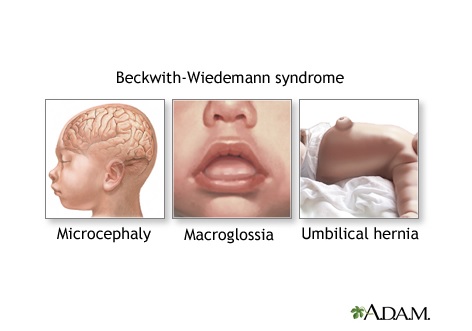OVERVIEW
Beckwith Wiedemann Syndrome (BWS) is an overgrowth disorder characterized by large body size, enlarged organs, macroglossia (enlarged tongue), abdominal wall abnormalities, and increased risk for certain types of childhood liver and kidney tumors.
CAUSES
The cause of Beckwith-Wiedemann syndrome is associated with a change in the genes of chromosome 11. This is where growth factor (IGF-2) and CDKN1C (slows cell growth) is located. About 85% of BWS cases are sporadic or occur randomly in 1 of 15,000 births.
CHARACTERISTICS
Infancy is a critical period due to serious medical issues that may be present at birth or arise in early childhood.
- Hypoglycemia: low blood sugar (neonatal hypoglycemia)
- Abodominal wall defects
- umbilical hernia
- omphalocele: where the infant's intestines or other organs protrude out of the belly button (exomphalos)
- diastasis recti: separated abdominal muscles
- Macroglossia: enlarged tongue (macroglossia)
- Microcephaly: a significantly smaller head than normal based on standardized growth charts.
Wilm's tumor: kidney cancer that primarly affects children. Also known as nephroblastoma.
- Hepatoblastoma: a malignant liver neoplasm occurring in infants and children. The disease is most commonly diagnosed during a child's first three years of life. Alpha-fetoprotein (AFP) commonly is elevated, but when AFP is not elevated at diagnosis the prognosis is poor.
- Hemihypertrophy: one side of the body or parts of one side of the body grow larger than the other ( hemihypertrophy)
- Ear abnormalities: ear pits or creases, or low-set ears.
- Metopic ridge: a ridge in the forehead caused by premature closure of the bones
- Macrosomia: large body size in 90th percentile (macrosomia)
- Seizures
- Enlarged organs
Where to locate ear pits and creases
MEDICAL SCREENINGS AND TESTS
- Blood tests for hypoglycemia
- Chromosomal studies for chromosome 11 abnormalities
- MRI or CT scan of the abdomen
- Ultrasound of the abdomen every 12 weeks to screen for tumors
- X-ray of the large bones
- Alpha-fetoprotein (AFP) blood test every 6 weeks to screen for tumors
PROGNOSIS
It is important to help raise awareness of BWS because detecting this syndrome early in childhood will help increase a child's likelihood of a long and healthy life. Children with Beckwith-Wiedemann Syndrome have normal mental development and no significant delays. However, they may experience speech problems related to macroglossia. Besides being slightly larger than their peers during childhood, they seem to be an expected size in adulthood based on their parents' height and weight. Although children with BWS are at an increased risk for hypoglycemia, childhood cancer, and premature births, most children with BWS have a positive prognosis due to the advances in treating neonatal complications and cancer screenings.
More articles:
BWS Genetics, AFP blood draws, and Ultrasounds - Find out more information about the genetic factors behind BWS, AFP and Ultrasound screenings for cancer.
BWS Resources - resources and information to help you along your journey.
Holistic Remedies for Cancer Prevention - recipes, cancer prevention tips, and more
REFERENCES
Acknowledgments. The information on this page was taken from the following resources:
- National Library Medicine http://www.ncbi.nlm.nih.gov/pubmedhealth/PMH0002168/
- Cancer.Net http://www.cancer.net/cancer-types/beckwith-wiedemann-syndrome
- Wikipedia http://en.wikipedia.org/wiki/Beckwith%E2%80%93Wiedemann_syndrome



